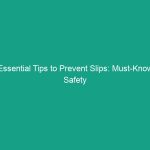Good Morning Team!
Today, we’re diving into a crucial aspect of Workplace Safety: Must-Know Fall Hazard Surveys: Identifying and Mitigating Risks Effectively. Understanding and addressing Fall Hazards is not just a compliance obligation; it’s a matter of ensuring our Safety and well-being on the job. Let’s explore why this topic is essential for our daily operations and how we can proactively prevent accidents.
Understanding Must-Know Fall Hazard Surveys
Fall hazard surveys are systematic approaches to identifying potential fall risks in the workplace. These surveys are essential in ensuring that we maintain a safe working Environment, especially in industries where falls are prevalent, such as construction, manufacturing, and warehousing.
The importance of conducting these surveys cannot be overstated. They help us recognize problems before accidents occur, allowing us to implement solutions that protect everyone. A common misconception is that these surveys are only necessary for specific roles or projects. In reality, every employee can be affected by fall Hazards, regardless of their position.
Key Hazards, Risks, and Safety Considerations
When conducting fall hazard surveys, it’s imperative to identify key hazards and risks associated with our work environments. Here are some common fall hazards:
- Unstable surfaces: Slippery floors, uneven ground, and loose mats can lead to slips and falls.
- Improper use of ladders: Using ladders that are not compliant with safety Standards can result in serious injuries.
- Working at heights: Employees working on scaffolding or rooftops are at increased risk if proper Safety Measures are not followed.
- Inadequate Training: Lack of proper training on Fall Prevention equipment can lead to misuse and accidents.
Ignoring these risks can have severe consequences, including injuries that may result in long-term disabilities or even fatalities. It’s not just about compliance; it’s about protecting our team members and their families.
Best Practices, Procedures, & Actionable Advice
Now that we understand the hazards, let’s discuss practical steps we can take to mitigate these risks:
- Conduct Regular Surveys: Schedule regular fall hazard surveys to keep up with changes in the workplace. This will help identify new risks as they arise.
- Implement Control Measures: Once hazards are identified, take immediate action. This may include repairing unstable surfaces, ensuring proper ladder usage, and providing safety barriers for elevated work areas.
- Provide Training: Ensure all employees receive comprehensive training on fall hazards and the correct use of Fall Protection equipment.
- Encourage Reporting: Foster an environment where employees feel comfortable reporting potential hazards. The sooner we know about a problem, the sooner we can address it.
Let’s look at a real-world incident. In a recent case, a worker fell from a height while attempting to access a roof without adequate Safety Measures in place. The investigation revealed that a fall hazard survey had not been conducted, and safety protocols were not being followed. This incident could have been prevented with proper planning and training.
Regulations, Standards, and Compliance
It’s vital to understand the regulatory framework surrounding fall hazards. The Occupational Safety and Health Administration (OSHA) provides guidelines for fall protection standards, including:
- Proper use of Personal Protective Equipment (PPE).
- Standards related to ladders, scaffolding, and other equipment.
- Training requirements for employees at risk of falls.
Compliance with these Regulations is not just about avoiding fines; it protects the workforce and promotes a culture of safety. When we adhere to these standards, we create a safer environment for everyone.
Employee Engagement & Discussion
Now, let’s open the floor for discussion. I’d like to hear your thoughts and experiences regarding fall hazards. Here are a few questions to consider:
- What safety challenges have you encountered related to fall hazards?
- Can you share any successful strategies or practices that have worked in preventing falls?
- How can we improve our current safety measures regarding fall hazards?
Your insights are invaluable, and together we can enhance our safety protocols.
Conclusion & Key Takeaways
In conclusion, understanding and effectively conducting fall hazard surveys is essential for Workplace Safety. By identifying risks and implementing Best Practices, we can significantly reduce the likelihood of falls and protect our colleagues. Remember, safety is a shared responsibility, and each of us plays a crucial role in creating a safe work environment.
Thank you all for your attention and commitment to safety. Let’s prioritize these practices and ensure that we look out for one another. Together, we can make our workplace a safer place!


